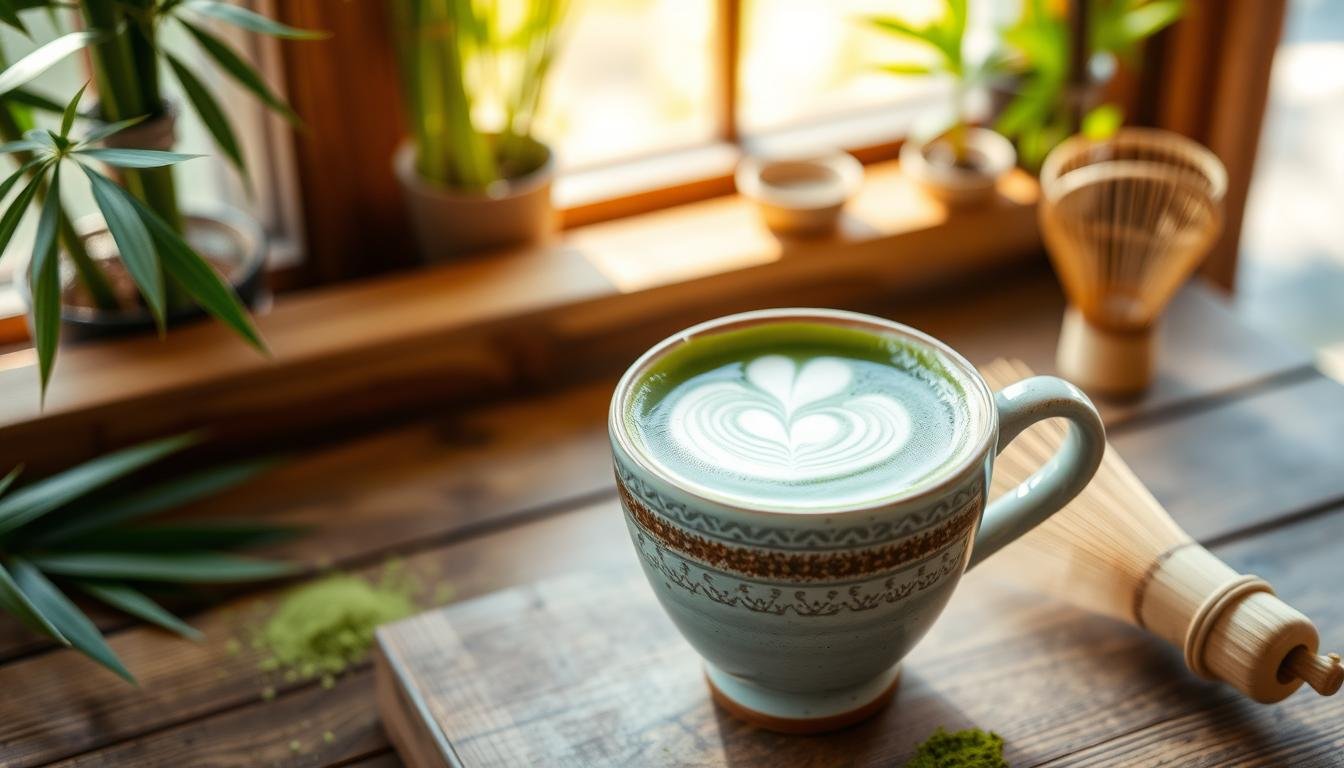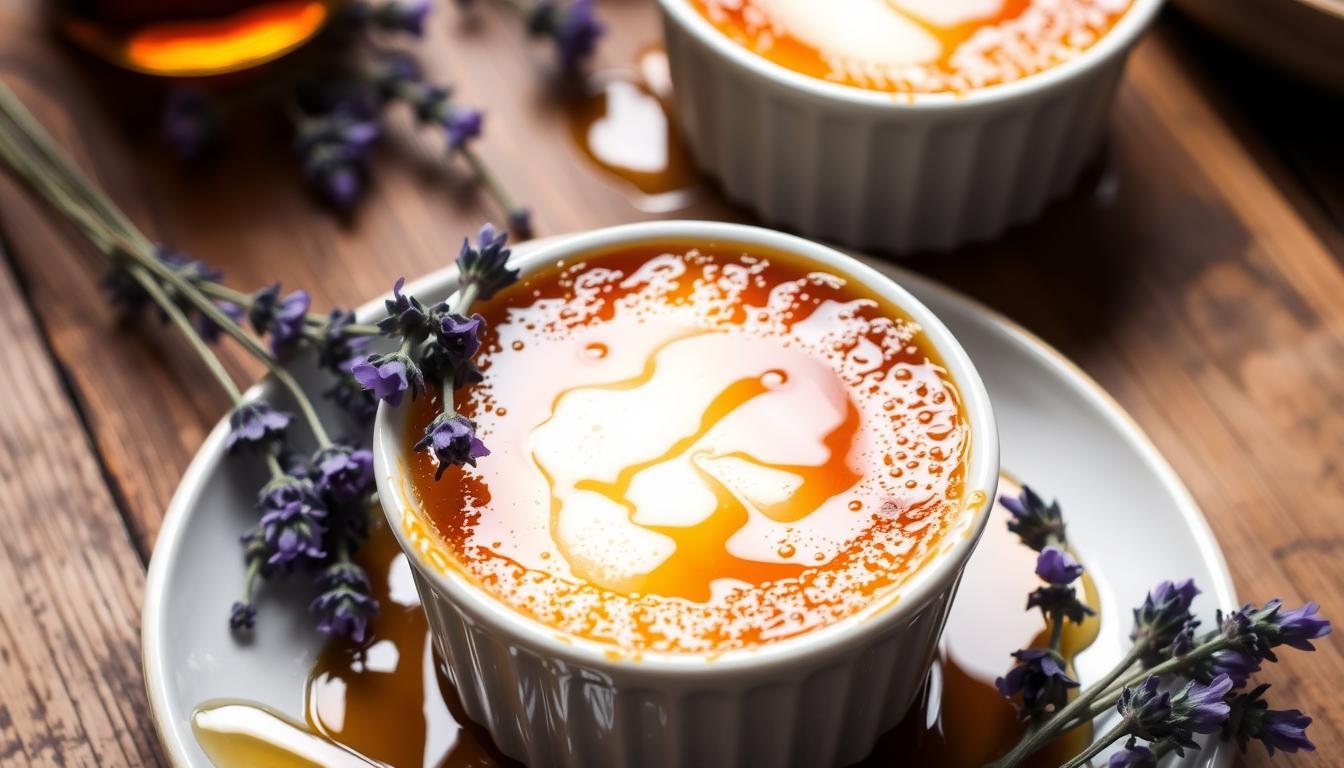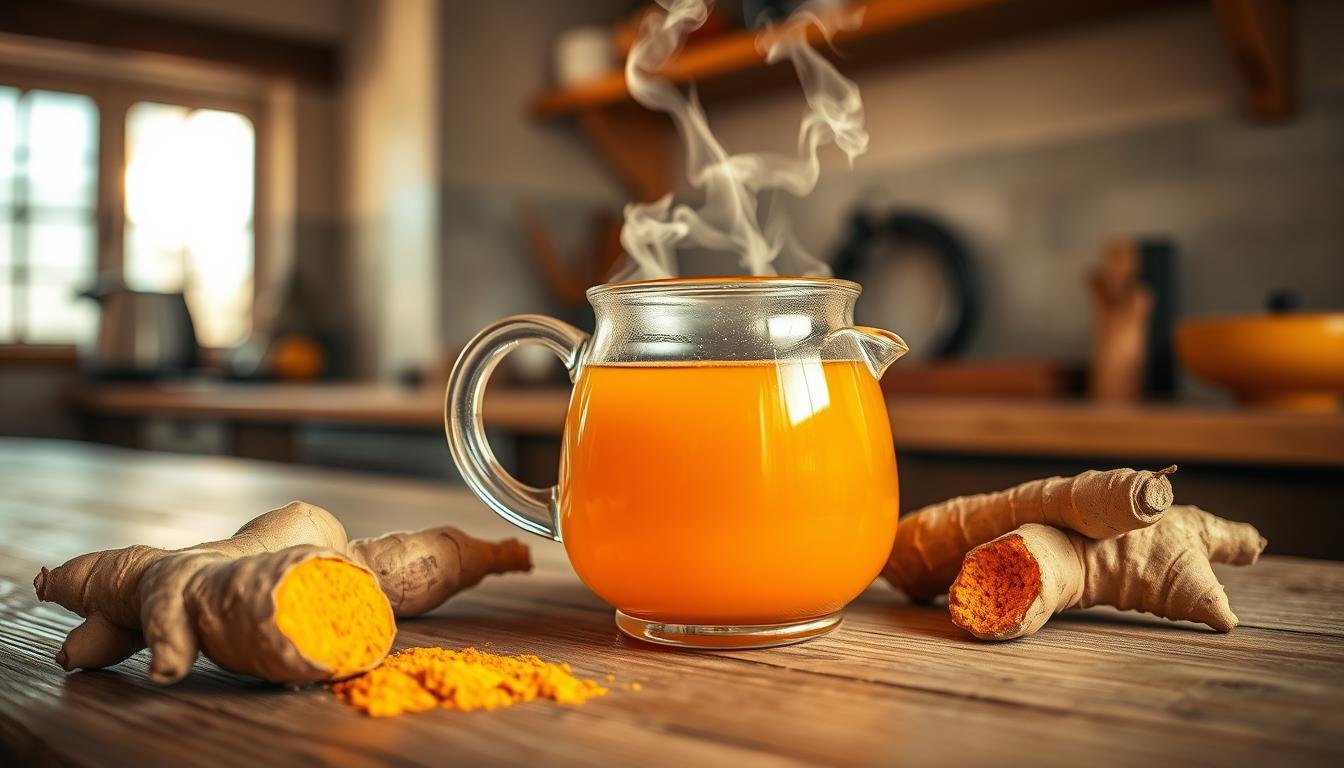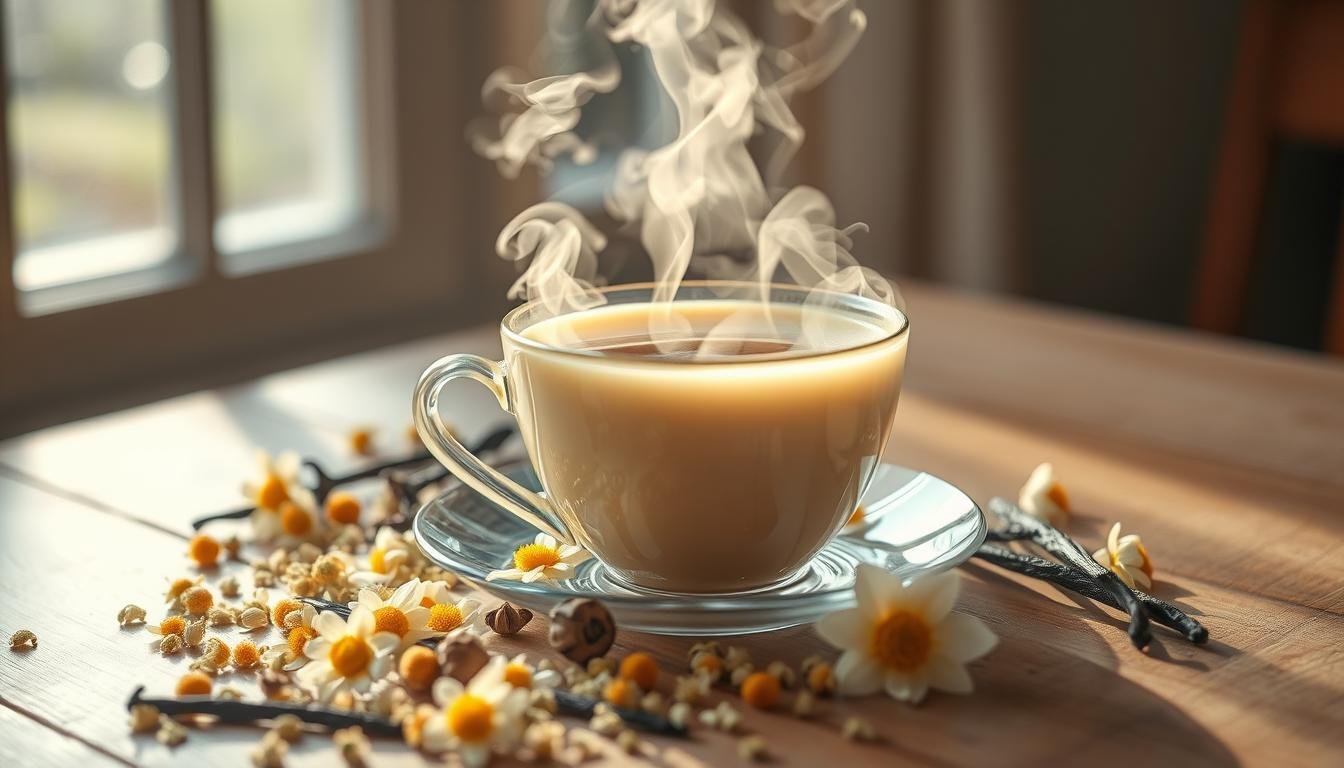Welcome to the world of Matcha Green Tea Latte! This drink has become very popular, found in coffee shops and homes. At Recipe Keepers, we love finding tasty and healthy drinks to make your day better.
Matcha is special. It’s a powdered tea with lots of nutrients, about 10 times more than regular green tea. It’s loved by those who want a healthy drink that tastes great. You can find it at Starbucks and local cafes.
Are you ready to explore a mix of ancient Japanese traditions and modern cooking? Our guide will show you how to make a perfect matcha latte at home. It’s great for both tea lovers and those new to it.
Key Takeaways
- Matcha powder offers 10x more nutrients than traditional green tea
- Preparation time is just 5 minutes for a delicious latte
- Only ½ to 1 teaspoon of matcha powder is needed per serving
- Matcha lattes are now widely available in major coffee chains
- Each serving contains approximately 63 calories
Understanding the Ancient Origins of Matcha Tea
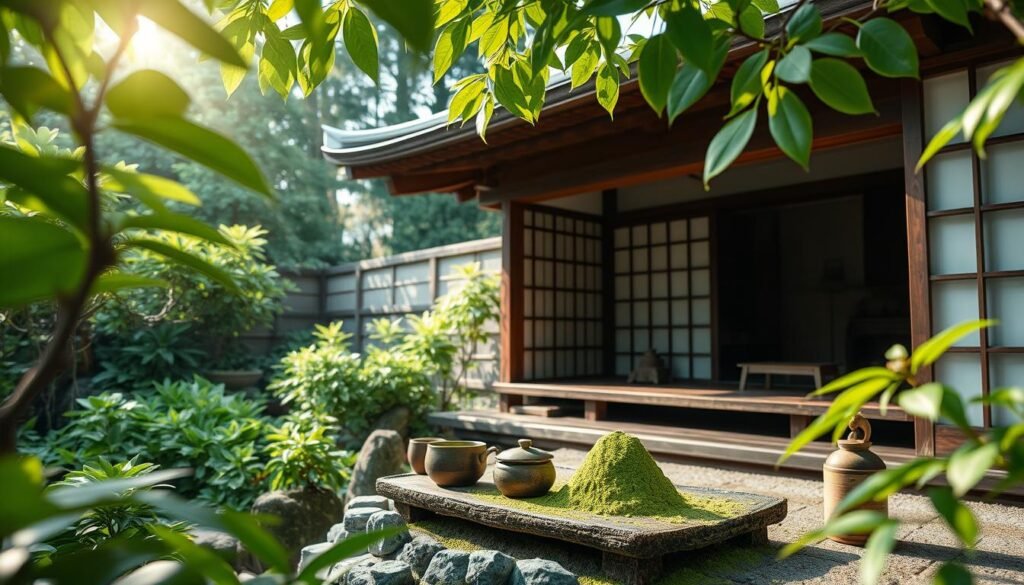
The story of Japanese matcha is a captivating journey through time. It is rooted in rich cultural traditions that span centuries. From its humble beginnings to becoming a global phenomenon, matcha has evolved from a simple beverage to a symbol of Japanese heritage and spiritual practice.
Traditional Tea Ceremony Roots
Japanese matcha emerged in the 12th century, introduced by Buddhist monks who valued its remarkable properties. The monk Eisai played a key role in bringing tea seeds to Japan. This transformed the landscape of tea cultivation in the Kyoto region.
- Zen Buddhist monks used matcha during meditation
- Tea preparation became a spiritual practice
- Ritualistic preparation emphasized mindfulness
Evolution from Ceremonial Drink to Modern Favorite
Matcha’s journey continued through different historical periods, gaining prominence among samurai warriors and tea masters. The tea ceremony, known as “chado,” became a sophisticated art form. It embodied core principles of harmony, respect, purity, and tranquility.
| Historical Period | Matcha Significance |
|---|---|
| Kamakura Period (1185-1333) | Initial cultivation of Japanese matcha |
| Edo Period (1603-1868) | Popularity among elite classes |
| Late 20th Century | Global resurgence and health recognition |
Cultural Significance in Japanese Heritage
Japanese matcha transcended its original purpose, becoming more than just a beverage. It represents a profound connection to meditation, mindfulness, and cultural identity. Today, matcha continues to bridge traditional practices with modern wellness trends. It captivates people worldwide with its unique flavor and rich history.
What Sets Matcha Apart from Regular Green Tea
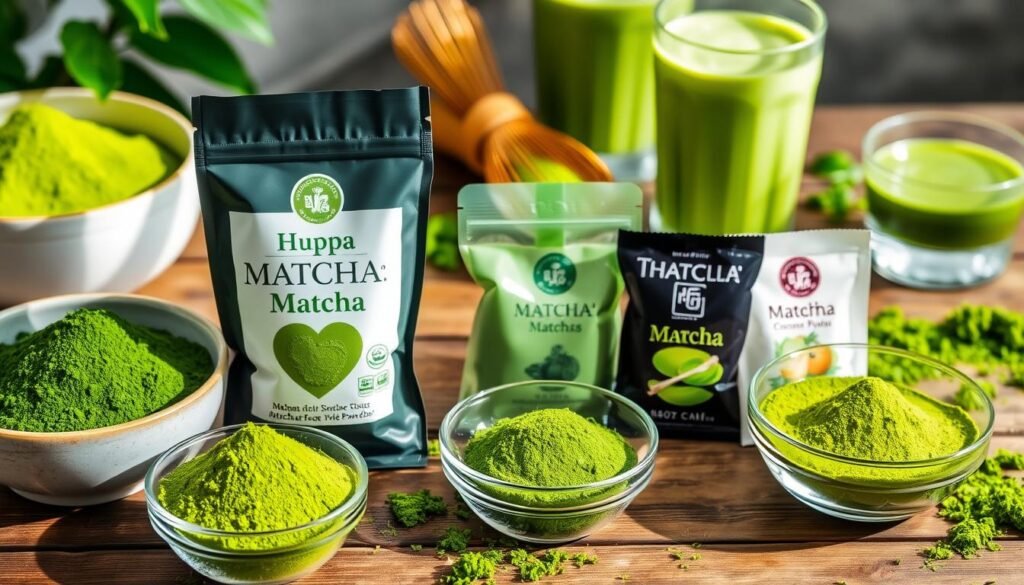
Matcha is a unique tea experience. It’s different from regular green tea in how it’s consumed and prepared. The main difference is in the way matcha is made and enjoyed.
- Whole Leaf Consumption: Matcha involves consuming the entire tea leaf, not just steeping and discarding
- Distinctive Preparation: Requires whisking instead of traditional steeping
- Concentrated Nutrient Profile: Provides significantly higher levels of beneficial compounds
Matcha tea plants are grown in the shade for three to four weeks before harvest. This increases their chlorophyll and nutrient content.
| Characteristic | Matcha | Regular Green Tea |
|---|---|---|
| Caffeine Content | 280 mg per serving | 35 mg per serving |
| Antioxidant Levels | 134 mg | 63 mg |
| Preparation Method | Whisked | Steeped |
Matcha offers more than regular green tea. It has more amino acids, tannins, and antioxidants. This makes matcha a powerful wellness option.
Matcha is a more complete tea experience. Grinding the whole leaf into a fine powder gives you all the nutrients. This is different from traditional tea brewing.
The Health Benefits of Matcha Green Tea Latte
Discover the incredible wellness potential in every vibrant green sip of matcha. This antioxidant-rich drink is more than a trend. It’s a powerful health ally that can change your daily routine.
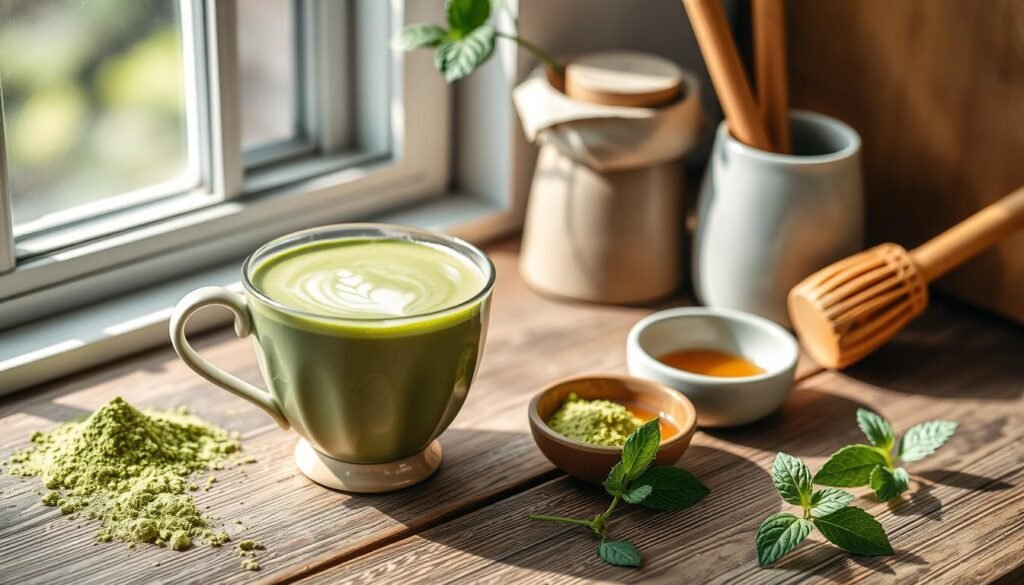
Matcha offers a wide range of health benefits. Its unique nutritional profile makes it a top choice for natural wellness support.
Powerful Antioxidant Protection
Matcha is a nutritional powerhouse. It has an ORAC rating of 1384 units per gram. This means it offers 125 times more antioxidant protection than spinach.
- Contains 10 times more antioxidants than regular green tea
- Rich in catechins, which fight free radicals
- Helps prevent cellular damage
Metabolism and Weight Management
Matcha is great for fitness enthusiasts. Studies show an 18% increase in caloric burn during exercise after drinking matcha. Its thermogenic properties can boost calorie burning rates up to 25%.
| Metabolic Benefit | Percentage Increase |
|---|---|
| Caloric Burn During Exercise | 18% |
| Potential Calorie Burning Rate | Up to 25% |
Mental Focus and Energy Enhancement
The unique mix of L-theanine and caffeine in matcha boosts mental performance. Studies show improved cognitive speed and accuracy. Alertness lasts 6-8 hours.
- Promotes relaxed alertness
- Increases energy within 15-20 minutes
- Supports cognitive function
With 32 documented health benefits, matcha is more than a drink. It’s a natural wellness strategy that can improve your health and performance.
Essential Ingredients for the Perfect Matcha Green Tea Latte
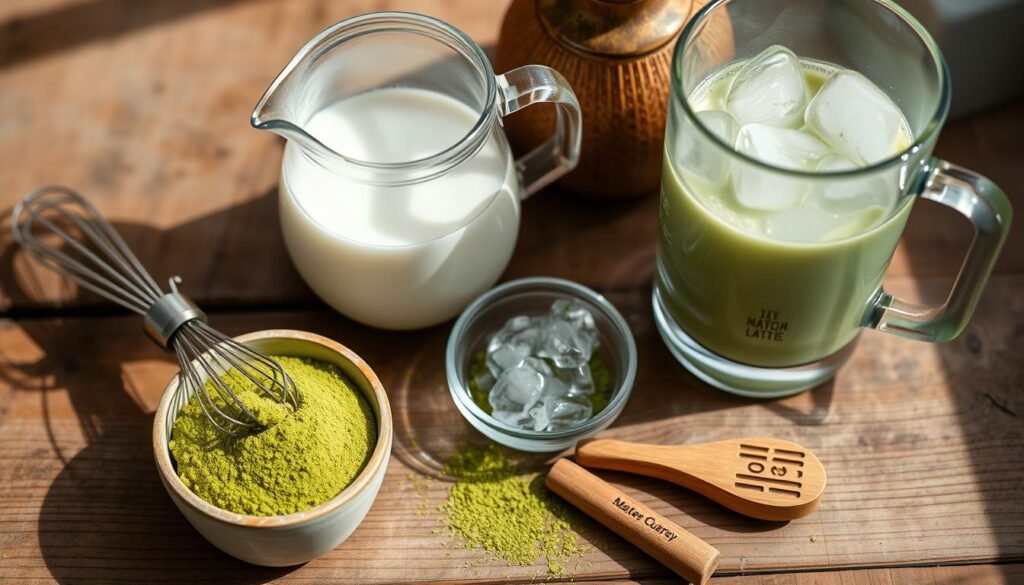
Making a tasty Matcha Green Tea Latte begins with picking the best ingredients. The key is high-quality matcha powder. It turns a simple drink into a special treat.
Here are the must-haves for a top-notch Matcha Green Tea Latte:
- Matcha Green Tea Powder (1 teaspoon)
- Hot water (1/4 cup)
- Milk of choice (1 cup)
- Sweetener (optional)
Choosing the right matcha powder is key. Go for ceremonial-grade matcha for the best taste. It’s sweeter and more refined than other types.
| Ingredient | Quantity | Nutritional Impact |
|---|---|---|
| Matcha Powder | 1 teaspoon | 137x more antioxidants than regular green tea |
| Milk (Oat/Almond) | 1 cup | Low in calories, adds creamy texture |
| Sweetener | 1-2 teaspoons | Adjustable to taste preference |
Your Matcha Green Tea Latte is not only yummy but also healthy. It has about 60 mg of caffeine and 76 calories. Try different milks to find your favorite mix!
Pro tip: Use water just below boiling point (around 175°F) to keep matcha’s flavor. It’s ready in about 10 minutes, making it a quick, healthy drink.
Step-by-Step Guide to Making Matcha Green Tea Latte
Want to make a perfect matcha latte at home? Our guide will show you how to do it with expert techniques. Whether you’re new to matcha or a fan, these steps will help you make a tasty and true-to-form drink.
Water Temperature and Whisking Secrets
For a top-notch matcha latte, start with precision. Heat your water to 175°F (79°C) to avoid burning the matcha. Sift 1-2 teaspoons of high-quality matcha into your bowl to get rid of lumps and achieve a silky texture.
- Sift matcha powder carefully
- Pour hot water at 175°F
- Whisk in a zigzag motion for 30 seconds
Milk Frothing Techniques
Frothing milk is key for a great matcha latte. Use a bamboo whisk for a smooth, creamy froth. If you don’t have a whisk, a milk frother or electric whisk will also work.
| Milk Type | Frothing Difficulty | Recommended For |
|---|---|---|
| Whole Milk | Easy | Richest flavor |
| Almond Milk | Moderate | Dairy-free option |
| Oat Milk | Easy | Creamy texture |
Customizing Your Sweet Spot
Make your matcha latte your own by adjusting the sweetness. Add 1-2 teaspoons of honey or your favorite sweetener. Start small and taste as you go, adding more until it’s just right.
- Honey: Natural sweetener
- Maple syrup: Rich flavor
- Stevia: Low-calorie option
With these tips, you’ll make a matcha latte that’s as good as any coffee shop’s. Have fun and find your own special way to enjoy it!
Different Grades of Matcha and Their Best Uses
Not all matcha is the same. Knowing the different grades helps you pick the right one. Each grade has its own special qualities and uses, from ceremonial to culinary.
Matcha falls into two main types: ceremonial and culinary. Let’s explore the world of matcha grades and their unique qualities.
Ceremonial Grade Matcha
- Highest quality best matcha powder
- Derived from youngest tea leaves
- Vibrant green color with fine texture
- Naturally sweet flavor
- Ideal for traditional drinking
Culinary Grade Matcha
Culinary grade matcha is great for cooking and baking. It comes in several subgrades:
- Premium Grade: Best for lattes and smoothies
- Café Grade: Robust flavor for baking
- Ingredient Grade: Strong profile for recipes
- Kitchen Grade: Intense flavor for large-scale brewing
- Classic Grade: Most commonly available
Think about how you plan to use your matcha. Ceremonial grade is perfect for traditional drinks. Culinary grades are better for creative recipes and drinks.
Pro tip: Always choose organic, Japanese matcha from places like Uji. It ensures top quality and real flavor.
Creative Variations and Flavor Combinations
Unleash your inner barista and explore the exciting world of matcha latte recipes! Our culinary journey will transform your everyday drink into a canvas of delightful flavors and innovative combinations. Whether you’re a matcha enthusiast or a curious newcomer, these creative variations will elevate your matcha latte experience.
Seasonal Matcha Latte Inspirations
Embrace the seasons with these unique matcha latte recipes that capture the essence of each time of year. Our curated selection offers something special for every palate and mood.
- Pumpkin Spice Matcha Latte: Autumn’s cozy favorite with added vitamin A from pumpkin puree
- Iced Strawberry Matcha Latte: A refreshing summer drink reminiscent of the Starbucks Pink Drink
- Hibiscus Matcha Latte: Combines health benefits of hibiscus and matcha tea
Hot vs. Iced Preparation Methods
Master the art of preparing matcha lattes with our expert techniques. Whether you prefer a steaming hot cup or a cool, refreshing drink, we’ve got you covered.
| Preparation Style | Milk Recommendation | Matcha Powder |
|---|---|---|
| Hot Matcha Latte | Whole milk or non-dairy alternative | 2 teaspoons of high-quality Japanese matcha |
| Iced Matcha Latte | 5 oz. non-dairy milk | 2 teaspoons of matcha powder |
Popular Add-ins and Toppings
Transform your matcha latte recipe with these exciting add-ins that provide extra flavor and nutrition:
- Vanilla Matcha Hot Chocolate: A cozy winter twist
- Matcha Bubble Milk Tea: Adding chewy tapioca pearls
- Adaptogenic Latte Blend: Boost energy and reduce stress
Experiment with these creative matcha latte recipes and discover your perfect blend. From seasonal specialties to unique flavor combinations, there’s a matcha latte waiting to become your new favorite drink!
Common Mistakes to Avoid When Preparing Matcha
Learning to make perfect matcha can be challenging. But knowing common mistakes helps you make a tasty drink every time. Matcha needs precision and care to bring out its full flavor.
Here are the key mistakes to avoid when preparing your matcha:
- Using water that’s too hot: Temperatures above 80°C (176°F) can make your matcha taste bitter. The ideal range is between 140°F and 170°F
- Skipping the sifting step: Unsifted matcha leads to clumpy, uneven drinks. Take time to sift your powder for smooth results
- Incorrect powder-to-water ratio: The recommended measurement is 1 teaspoon (about 2 grams) of matcha per 8 ounces of water
Whisking technique is crucial when learning how to make matcha. Proper whisking involves using a bamboo whisk in a brisk “M” or “W” motion for 2-3 to create a smooth, frothy texture.
Storage is another critical aspect of matcha preparation. Always keep your matcha in an opaque, airtight container away from direct light. This helps preserve its quality for up to six months, though it’s best consumed within two to three months after opening.
Quality matters significantly. Low-grade matcha can lack flavor and potentially contain fewer antioxidants. Invest in high-quality ceremonial grade matcha for the best taste and health benefits.
Tools and Equipment for Matcha Latte Preparation
Making the perfect matcha latte starts with the right tools. Traditional Japanese methods use special equipment for a true experience. A handcrafted chawan (matcha bowl) adds a unique touch, with each piece showing its own design.
Your basic matcha recipe toolkit has a bamboo chashaku (tea scoop) for 1-2 grams of powder. You also need a chasen (bamboo whisk) with 80-120 prongs. For quicker prep, an electric matcha frother is a good choice. A fine furui (sifter) is key for a smooth blend.
For modern tea lovers, a digital temperature-controlled kettle is a must. It helps with precise brewing. Beginner kits usually include a bowl, scoop, whisk, sifter, and 30g of premium matcha powder. Quality tools make your matcha latte prep special, whether you’re a traditionalist or a tech fan.
